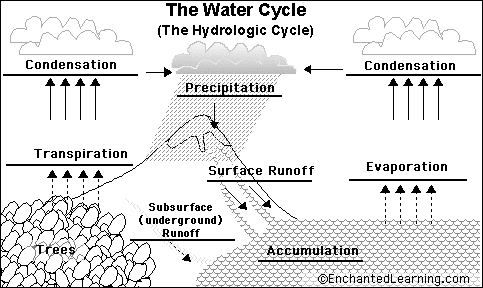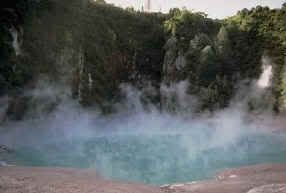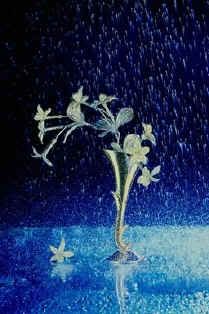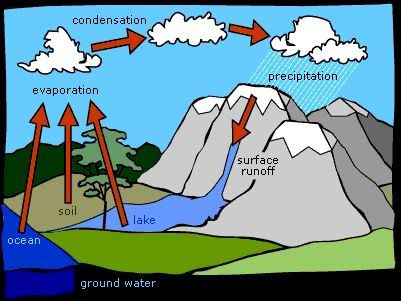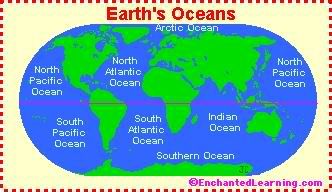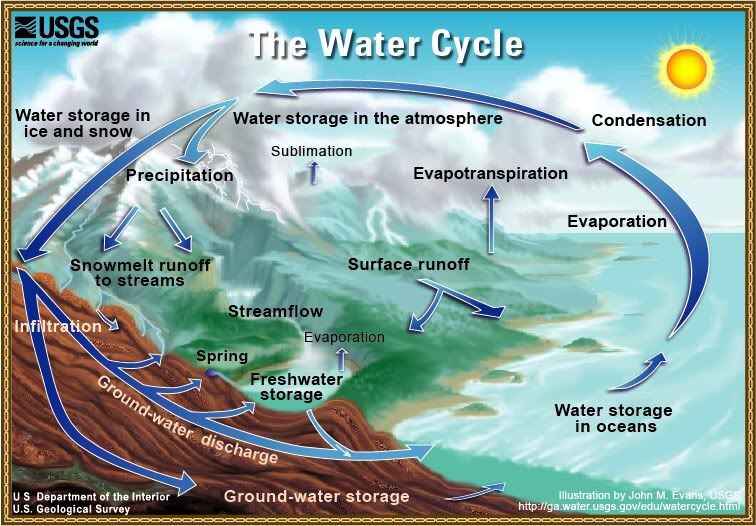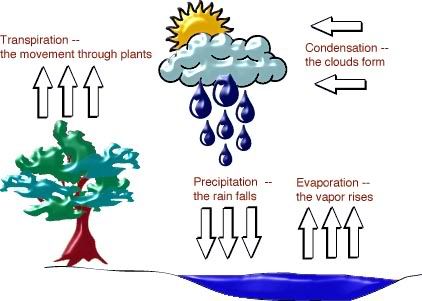Accumulation - the process in which water pools in large bodies (like oceans, seas and lakes).
Condensation - the process in which water vapor (a gas) in the air turns into liquid water. Condensing water forms clouds in the sky. Water drops that form on the outside of a glass of icy water are condensed water. (This term appears twice in the diagram.)
Evaporation - the process in which liquid water becomes water vapor (a gas). Water vaporizes from the surfaces of oceans and lakes, from the surface of the land, and from melts in snow fields.
Precipitation - the process in which water (in the form of rain, snow, sleet, or hail) falls from clouds in the sky.
Subsurface Runoff - rain, snow melt, or other water that flows in underground streams, drains, or sewers.
Surface Runoff - rain, snow melt, or other water that flows in surface streams, rivers, or canals.
Transpiration - the process in which some water within plants evaporates into the atmosphere. Water is first absorbed by the plant's roots, then later exits by evaporating through pores in the plant.
__________________
The Water Cycle
Run and get a glass of water and put it on the table next to you. Take a good long look at the water. Now -- can you guess how old it is?
The water in your glass may have fallen from the sky as rain just last week, but the water itself has been around pretty much as long as the earth has!
When the first fish crawled out of the ocean onto the land, your glass of water was part of that ocean. When the Brontosaurus walked through lakes feeding on plants, your glass of water was part of those lakes. When kings and princesses, knights and squires took a drink from their wells, your glass of water was part of those wells.
And you thought your parents were OLD
The earth has a limited amount of water. That water keeps going around and around and around and around and (well, you get the idea) in what we call the "Water Cycle".
This cycle is made up of a few main parts:
* evaporation (and transpiration)
* condensation
* precipitation
* collection
Evaporation is when the sun heats up water in rivers or lakes or the ocean and turns it into vapor or steam. The water vapor or steam leaves the river, lake or ocean and goes into the air.
Condensation:
Water vapor in the air gets cold and changes back into liquid, forming clouds. This is called condensation.
You can see the same sort of thing at home... pour a glass of cold water on a hot day and watch what happens. Water forms on the outside of the glass. That water didn't somehow leak through the glass! It actually came from the air. Water vapor in the warm air, turns back into liquid when it touches the cold glass.
Precipitation:
Precipitation occurs when so much water has condensed that the air cannot hold it anymore. The clouds get heavy and water falls back to the earth in the form of rain, hail, sleet or snow.
Collection:
When water falls back to earth as precipitation, it may fall back in the oceans, lakes or rivers or it may end up on land. When it ends up on land, it will either soak into the earth and become part of the “ground water” that plants and animals use to drink or it may run over the soil and collect in the oceans, lakes or rivers where the cycle starts
all over again.
The Water Cycle
Water on Earth is always changing. Its repeating changes make a cycle. As water goes through its cycle, it can be a solid (ice), a liquid (water), or a gas (water vapor). Ice can change to become water or water vapor. Water can change to become ice or water vapor. Water vapor can change to become ice or water.
Image displaying the Water Cycle. Please have someone assist you with this.
How do these changes happen? Adding or subtracting heat makes the cycle work. If heat is added to ice, it melts. If heat is added to water, it evaporates. Evaporation turns liquid water into a gas called water vapor.
If heat is taken away from water vapor, it condenses. Condensation turns water vapor into a liquid. If heat is taken away from liquid water, it freezes to become ice.
The water cycle is called the hydrologic cycle. In the hydrologic cycle, water from oceans, lakes, swamps, rivers, plants, and even you, can turn into water vapor. Water vapor condenses into millions of tiny droplets that form clouds. Clouds lose their water as rain or snow, which is called precipitation. Precipitation is either absorbed into the ground or runs off into rivers. Water that was absorbed into the ground is taken up by plants. Plants lose water from their surfaces as vapor back into the atmosphere. Water that runs off into rivers flows into ponds, lakes, or oceans where it evaporates back into the atmosphere.
The cycle continues.
The Water Cycle (also known as the hydrologic cycle) is the journey water takes as it circulates from the land to the sky and back again.
The Sun's heat provides energy to evaporate water from the Earth's surface (oceans, lakes, etc.). Plants also lose water to the air (this is called transpiration). The water vapor eventually condenses, forming tiny droplets in clouds. When the clouds meet cool air over land, precipitation (rain, sleet, or snow) is triggered, and water returns to the land (or sea). Some of the precipitation soaks into the ground. Some of the underground water is trapped between rock or clay layers; this is called groundwater. But most of the water flows downhill as runoff (above ground or underground), eventually returning to the seas as slightly salty water.
WHY ARE THE OCEANS SALTY?
Oceans cover about 70% of the Earth's surface. The oceans contain roughly 97% of the Earth's water supply.
As water flows through rivers, it picks up small amounts of mineral salts from the rocks and soil of the river beds. This very-slightly salty water flows into the oceans and seas. The water in the oceans only leaves by evaporating (and the freezing of polar ice), but the salt remains dissolved in the ocean - it does not evaporate. So the remaining water gets saltier and saltier as time passes.
A quick summary of the water cycle
Where does all the Earth’s water come from? Primordial Earth was an incandescent globe made of magma, but all magmas contain water. Water set free by magma began to cool down the Earth’s atmosphere, until it could stay on the surface as a liquid. Volcanic activity kept and still keeps introducing water in the atmosphere, thus increasing the surface- and ground-water volume of the Earth.
The water cycle has no starting point. But, we'll begin in the oceans, since that is where most of Earth's water exists. The sun, which drives the water cycle, heats water in the oceans. Some of it evaporates as vapor into the air. Ice and snow can sublimate directly into water vapor. Rising air currents take the vapor up into the atmosphere, along with water from evapotranspiration, which is water transpired from plants and evaporated from the soil. The vapor rises into the air where cooler temperatures cause it to condense into clouds. Air currents move clouds around the globe, cloud particles collide, grow, and fall out of the sky as precipitation. Some precipitation falls as snow and can accumulate as ice caps and glaciers, which can store frozen water for thousands of years. Snowpacks in warmer climates often thaw and melt when spring arrives, and the melted water flows overland as snowmelt.
Most precipitation falls back into the oceans or onto land, where, due to gravity, the precipitation flows over the ground as surface runoff. A portion of runoff enters rivers in valleys in the landscape, with streamflow moving water towards the oceans. Runoff, and ground-water seepage, accumulate and are stored as freshwater in lakes. Not all runoff flows into rivers, though. Much of it soaks into the ground as infiltration. Some water infiltrates deep into the ground and replenishes aquifers (saturated subsurface rock), which store huge amounts of freshwater for long periods of time. Some infiltration stays close to the land surface and can seep back into surface-water bodies (and the ocean) as ground-water discharge, and some ground water finds openings in the land surface and emerges as freshwater springs. Over time, though, all of this water keeps moving, some to reenter the ocean, where the water cycle "ends" ... oops - I mean, where it "begins."
Global water distribution
For a detailed explanation of where Earth's water exists, look at the chart and data table below. By now, you know that the water cycle describes the movement of Earth's water, so realize that the chart and table below represent the presence of Earth's water at a single point in time. If you check back in a thousand or million years, no doubt these numbers will be different!
Notice how of the world's total water supply of about 332.5 million cubic miles of water, over 96 percent is saline. And, of the total freshwater, over 68 percent is locked up in ice and glaciers. Another 30 percent of freshwater is in the ground. Fresh surface-water sources, such as rivers and lakes, only constitute about 22,300 cubic miles (93,100 cubic kilometers), which is about 1/150th of one percent of total water. Yet, rivers and lakes are the sources of most of the water people use everyday.
The Cycle
Water is constantly being cycled between the atmosphere, the ocean and land. This cycling is a very important process that helps sustain life on Earth.
As the water evaporates, vapors rise and condense into clouds. The clouds move over the land, and precipitation falls in the form of rain, ice or snow. The water fills streams and rivers, and eventually flows back into the oceans where evaporation starts the process anew. Learn a lot more about this complicated process in concepts.
Water's state (solid, liquid or gas) is determined mostly by temperature. Although water continuously changes states from solid to liquid to gas, the amount of water on Earth remains constant. There is as much water now as there was hundreds of millions of years ago.
